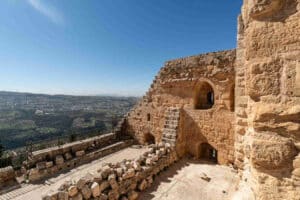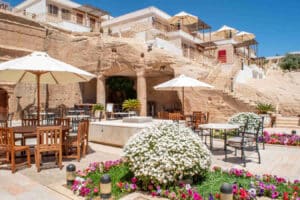Visiting the Church of St. John the Baptist in Madaba is one of the main cultural options in this city, known for being an authentic bridge between Christians and Muslims. Its Byzantine churches preserve some of the most spectacular mosaics of that period, as we have mentioned in other posts on this blog. Below, we present the most interesting aspects of this temple.
What is the Church of St. John the Baptist in Madaba like?
The Church of St. John the Baptist in Madaba is a Christian temple of the Catholic rite. Its exact name is the “Church of the Beheading of St. John the Baptist“: this gruesome episode did not happen here exactly, but very close by, in the castle of Machaerus, located on a hill overlooking the Dead Sea.
Therefore, a good part of the iconography displayed here refers to the death of the Christian saint, at the initiative of Salome to seduce Herod, as John opposed the union between them. The representation of the baptism of Christ, carried out by the titular saint in the Jordan River, also near this city, is also very common.
The temple has an old appearance, but its construction is relatively recent: it dates back to the late 19th century and early 20th century, at the initiative of several Italian priests, when only remains of an old Christian monastery were here. Its facade of large ashlars has clear Western reminiscences, with inspiration in the French Romanesque style. And its old appearance is no coincidence: some of those ashlars come from the ruins of the aforementioned monastery.
Why Visit the Church Inside
The Church of St. John the Baptist in Madaba can be visited when there is no mass inside, for which it is necessary to get a ticket of symbolic price. And many people wonder if it is worth visiting. The answer is yes, because, beyond the architecture of the temple itself, its interior houses works and corners of enormous historical value.
The oldest and most archaeologically interesting is located in the basement, where a well from the Moabite period has been discovered, a pre-Roman Semitic civilization that inhabited this territory during the first millennium BC, mainly.
It is precisely in that basement, which has been extensively reconditioned, where the other great surprise of the complex is displayed: the Acropolis Museum. Its name is due to the fact that the church is located in what was the upper part of that Roman and Byzantine city, which underwent so many changes later.
It is an exhibition space where mosaics and archaeological pieces found here and in other parts of the city are exhibited. In some cases, they are original works, while in others they are exact copies, reproduced here for their enormous artistic and documentary value, despite the fact that the original is in other museums in the country or even the world.
Highlights include the compositions that show a schematic but recognizable Jerusalem, the Three Queens, and the hunting scenes, which are a catalog of animals of the time and weapons used in this activity. Zebras, dromedaries, and ostriches are clearly recognizable, despite their beautiful stylized forms.
Finally, it should also be said that the church’s bell tower is open to visitors. Going up is not only interesting to contemplate the panoramic views of the city, but also to see the bells up close, cast in 1922, as you can read on them.
For all this, the Church of St. John the Baptist in Madaba is one of the most active and beloved by the Catholic community of the city, with regular religious services and even events in the square that extends in front of its facade.



